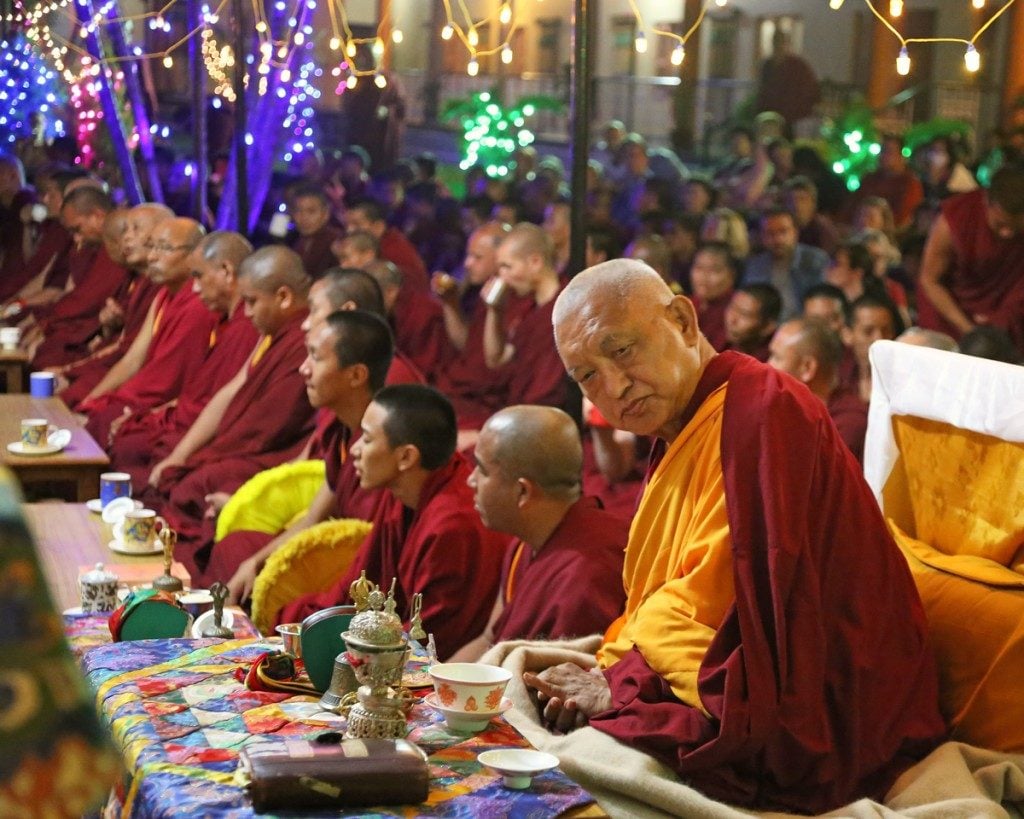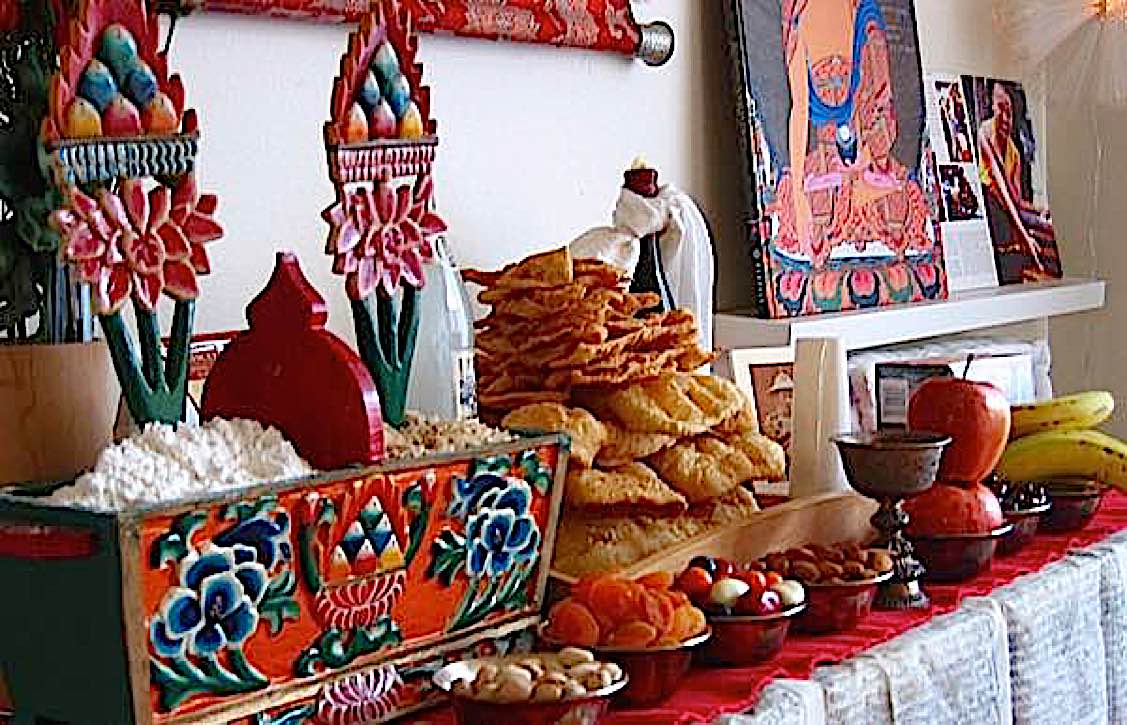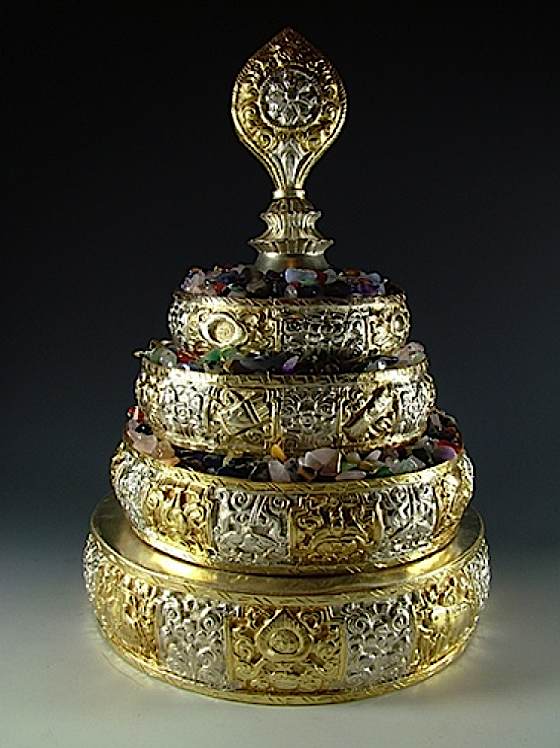Ganapuja (Gathering Offering) and Ganachakra (Gathering Circle) or Tsog (Tsok): What is it? Why is the Offering Important? When to Celebrate?

What is Ganapuja, Ganachakra or Tsog (Tsok) and why is it so precious and important?
From the Heruka Root Tantra regarding Ganachakra:
Quickly attempt to make offerings
Every waxing and waning of each month do tsog.
About Ganapuja from book of Chögyal Namkhai Norbu – Ganapuja, Shang Shung Edizioni
‘…we call the Ganapuja tun cog. Tun is practice session for a limited time, cog means ‘accumulation of merit’ via good actions. So Ganapuja means accumulation (gana) through offering (puja)…’
NOTE: Ganachakra or Tsog Dates for 2024 below in table.

GanaPuja or GanaChakra: What’s the Difference?
Ganachakra is what we call Tsog (Tsok). It simply means Accumulation Wheel (Gana is “accumulation” as in Accumulating Merit and Chakra is Wheel).
Ganapuja is what we call Tun Cog. It means Accumulation Offerings (Gana is “accumulation” and Puja is offerings.)
Ganachakra is more formal than Ganapuja, and traditionally is a commitment for people with certain empowerments on the 10th and 25th of each lunar month. Ganapuja is usually celebrated five times per month (including the 10th and 25th) but is not a commitment. It is an opportunity for accumulation of merit for the benefit of all.
We think of “gana” events as gatherings but even when we don’t “gather” — for example if we practice at home — we still visualize the entire Sangha participating. In Ganapuja creates merit and purifies negative karma. Ganachakra also creates skies of merit and purifies negative karma, but it also renews our vows and commitments.
Ganachakra Tsog Dates
Ganachakra (Tsog) offerings are traditionally made on two lunar dates each month — the 10th and the 25th:
- The 10th honors Guru Rinpoche, the Yidams, Wisdom and Compassion, and the Three Jewels and Three Roots
- The 25th honors the Dakinis (Dakini Day), the Wisdom Activity Dakinis, and the Three Jewels and Three Roots.
NOTE: All dates for this year at the bottom of this feature.
In other words, on both of these special offering days, we offer and ask for blessings from the Three Jewels and the Three Roots. On the 10th we are honoring Wisdom and Compassion and on the 25th we especially celebrate Buddha Activities (Dakinis):
- The outer Three Jewels are the Buddha, Dharma, and Saṅgha.
- Three Roots: the Guru (or Teacher), who is the root of blessings; the Yidam, who is the root of accomplishment; and the Dakini, who is the root of enlightened activity.
Ganapuja Dates
Ganapuja Dates are traditionally for everyone, and are on the lunar special dates: new moon and full moon in particular, Tara Day (the 8th of the Lunar Month) and — even if you don’t have empowerments for Ganachakra — we usually offer Ganapuja on the 10th and 25th days as well to honor the Yidams and Gurus (10th) and Dakinis and Activity Mothers (25th). So the five special days for Ganapuja (Accumulation of Merit) are:
- New Moon (special to Vajrasattva and associated with purifying negative karma) (last day of each lunar month)
- 8th of the Lunar Month (special to Tara and Medicine Buddha)
- 10th of the Lunar Month (Ganapuja if you don’t do Ganachakra Tsog, special for Guru Rinpoche and all Yidams)
- Full Moon (special to Amitabha and Shakyamuni Buddha and all Buddhas)
- 25th of the Lunar Month (Ganapuja if you don’t do Ganacharka or Tsog, special for all Dakinis and Activity Yidams)
For more on special Lunar Dates (together with all the dates in a calendar) see our feature>>>

Ganapuja or Ganachakra Tsog Purpose
The Heruka Root Tantra explains the purpose of Tsog offering, which is to remove obstacles and hardships:
The waxing and waning of each month
If good tsog is offered
Then one has no hardships, no difficulties
And one goes to the pure land of Tharpo Kachoe

Ganapuja, meaning Accumulation Offering is less formal and not normally considered a “commitment” — although it is highly meritorious. It simply means Accumulation Offering and is often a group event Puja, or a single person making Puja offerings on behalf of the Sangha. As long as we dedicate the merit of our Puja offering to all sentient beings and visualize the merits coming to all of our sangha, it is Ganapuja, and accumulates merits and purifies negative karma.
- Even though the 10th is dedicated especially to the Male aspects: Buddha, Guru (especially Guru Rinpoche Padmasambhava and the Male Yidams, we are actually offering to the entire merit field, all six of the Three Jewels and the Three Roots.
- The 25th, dedicated to the Female Wisdom Activity aspects (Dakinis) ad the Female Yidams, it is likewise offered to the entire merit field of Three Jewels and Three Roots.

Differences in Offerings
For GanaChakra there is always a prescribed Sadhana, with praises and songs and blessings, and always involves self-generating as your Yidam (visualizing yourself as your Yidam). For GanaPuja there is usually a Puja Offering, with frontal visualization or an altar set up to make offerings in front of the group or you. (No self generation is required, but if you have empowerment you may choose to do so.)
GanaPuja normally make offerings of Mandalas and outer sensory offerings, praises and songs and mantras. GanaChakra or Tsog always follows a more rigorous Sadhana, with extensive offerings, including special mantras, songs, and a feast. Often we are asked to bring food to the event. We offer it first to the Three Jewels and Three Roots, then especially to our teacher, then we may partake ourselves as well. The blessed offerings bless our mindstreams and renew our empowerments and commitments.

Ganachakra or Tsog Offering — What it means
H.E. Lama Zopa Rinpoche explains the higher meaning of Ganachakra or Tsog offerings:
“The very highest meaning of tsog is to join method and wisdom. The real meaning of experiencing tsog is the transcendental wisdom, non dual great bliss – the wisdom of emptiness, the non-duality of that, and uniting these two. That is the very essence of tsog. It is the offering of that experience, oneself experiencing it, the male and female heroes and heroines, of which the essence is the guru deity, and oneself also experiencing that, as the guru deity. The real meaning of tsog is integrating method and wisdom, the transcendental wisdom, non-dual bliss and voidness (this is the secret meaning).” [1]

Tsog is nearly always at night time. From the Heruka Root Tantra it is explained — night is symbolically when Dakas and Dakinis are more active:
Offering extensive food and drink
Always do at night time – why?
Because it is admired to do at nighttime
Always wander at nighttime and always gather at nighttime.
As always, with Buddhist offerings, the offerings are not “needed” by self-aware deities or Buddhas. The Enlightened have no need of sensory offerings. In general, offerings are an opportunity for us to earn merit to help overcome our negative karmas and attachments. The act of offering, or generosity, is also the “cure” for the grasping, attached mind. And, then there’s Tsog, which is precious especially to the Enlightened Dakinis and Dakas. [For a story on Dakinis and a previous story on Tsog, see>>]

In some practices, the Lunar 10th is often called the “Feast of Heroes” (Feast of Dakas) — and is often a celebration of Guru Rinpoche (Padmasambhava) — and the 25th is the “Feast of Heroines” (Feast of Dakinis.) In others, there is no distinction, so both days are called the “Feast of Dakas and Dakinis” or “Feast of Yogis and Yoginis” (Feast of Heroes and Heroines.)
Pandit Ratna Raksherita explained:
Those doing the activities of the heroes, it is called the feast of the heroes,
Similarly, those doing the activities of yoginis, it is called the feast of the heroines,
Those whose minds are enriched with control of the circle
Of the integrated method and wisdom,
That is called the circle of unification.
Ganachakra Tsog is special
Everything about Tsog is special. We might have tangible, sensory offerings in front of us, but they are “converted” in our minds and by our karmic actions, mantras, visualizations and practices into sacred, special, blissful NECTAR.
H.E. Lama Zopa Rinpoche explains the higher meaning and purpose of Tsog:
The meaning of nectar is not just some special taste, like honey. In Tibetan, the word is du-tsi.Du is mara, tsi is medicine. So here, du is ordinary appearance and ordinary concepts, delusions, negative imprints and defilements. Tsi means medicine —the ultimate medicine is the transcendental wisdom of non-dual bliss and voidness, which is like an atom bomb to cut through those delusions, which are the maras.
One has to think of the meaning of nectar, du-tsi, the transcendental wisdom of non-dual bliss and voidness. By taking that nectar, you generate that experience within you. If you don’t have the actual experience of that, then you visualize it. That blesses the mind, body, and the chakras, the winds and drops. It becomes a preparation to achieve the path, the Highest Tantra accomplishing path of the illusory body and clear light, and it enables you to achieve the resultant Dharmakaya and Rupakaya. Then, one is able to offer perfect works for sentient beings, without the slightest mistake, until everyone, every single sentient being, is brought to enlightenment.
Actual method for Ganachakra
Anyone may particiapte in both Ganapuja or Ganachakra (if invited) but if you attend Ganachakra without empowerment, you are there as a spectator. You do not self-generate.
For the actual method of Ganachakra, this must be guided/taught by a qualified teacher. Normally, you attend as a group, to the Gompa, temple or monastery. If you cannot, or if you are remote, you can do this on your own. There is a ceremony for those empowered to perform Tsog. If you have no empowerment, you can, if invited, attend and receive blessings, but in this case you do not perform the Sadhana portions that are self-generation, and you visualize the Yidams and merit field in front of you.
Dakini Day and Tsog 2024
- January 6
- February 5
- March 5
- April 4
- May 3
- July 1 and July 30
- August 28
- September 27
- October 26
- November 25
- December 25
Guru Rinpoche Day and Daka Tsog
- January 20
- February 19
- March 19
- April 18
- May 18
- June 16 Annual Birthday of Guru Rinpoche: Considered a Buddha Day
- July 16
- August 14
- September 13
- October 12
- November 11
- December 10
NOTES
[1] Source Lama Yeshe Wisdom Archive: “Tsog Offering Practice“
More articles by this author

Ganapuja (Gathering Offering) and Ganachakra (Gathering Circle) or Tsog (Tsok): What is it? Why is the Offering Important? When to Celebrate?

Honoring the Lotus Born: Guru Rinpoche Days – Celebrating the Lotus Born Padmasambhava Monthly on the 10th
Search
Latest Features
Please support the "Spread the Dharma" mission as one of our heroic Dharma Supporting Members, or with a one-time donation.
Please Help Support the “Spread the Dharma” Mission!

Be a part of the noble mission as a supporting member or a patron, or a volunteer contributor of content.
The power of Dharma to help sentient beings, in part, lies in ensuring access to Buddha’s precious Dharma — the mission of Buddha Weekly. We can’t do it without you!
A non-profit association since 2007, Buddha Weekly published many feature articles, videos, and, podcasts. Please consider supporting the mission to preserve and “Spread the Dharma." Your support as either a patron or a supporting member helps defray the high costs of producing quality Dharma content. Thank you! Learn more here, or become one of our super karma heroes on Patreon.
Lee Kane
Author | Buddha Weekly
Lee Kane is the editor of Buddha Weekly, since 2007. His main focuses as a writer are mindfulness techniques, meditation, Dharma and Sutra commentaries, Buddhist practices, international perspectives and traditions, Vajrayana, Mahayana, Zen. He also covers various events.
Lee also contributes as a writer to various other online magazines and blogs.
















